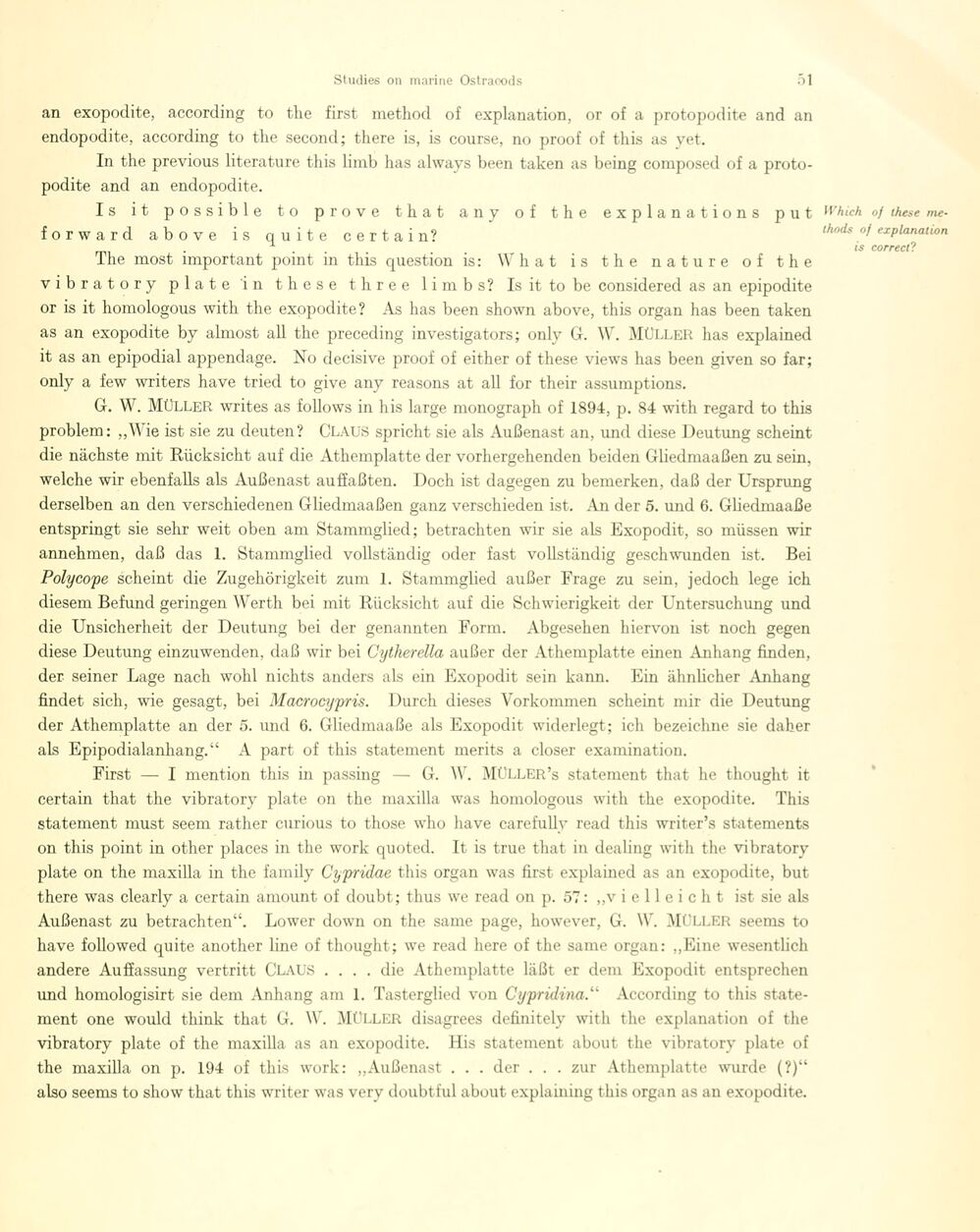
Full resolution (JPEG) - On this page / på denna sida - Sidor ...

<< prev. page << föreg. sida << >> nästa sida >> next page >>
Below is the raw OCR text
from the above scanned image.
Do you see an error? Proofread the page now!
Här nedan syns maskintolkade texten från faksimilbilden ovan.
Ser du något fel? Korrekturläs sidan nu!
This page has never been proofread. / Denna sida har aldrig korrekturlästs.
an exopodite, according to the first method of explanation, or of a protopodite and an
endopodite, according to the second; there is, is course, no proof of this as yet.
In the previous literature this limb has always been taken as being composed of a
proto-podite and an endopodite.
Is it possible to prove that any of the explanations put
forward above is quite certain?
The most important point in this question is: Wh a t is the nature of the
vibratory plate ’in these three li mb s? Isittobe considered as an epipodite
or is it homologous with the exopodite? As has been shown above, this organ has been taken
as an exopodite by almost all the preceding investigators; only G. W. MULLER has explained
it as an epipodial appendage. No decisive proof of either of these views has been given so far;
only a few writers have tried to give any reasons at all for their assumptions.
G. W. Müller writes as follows in his large monograph of 1894, p. 84 with regard to this
problem: „Wie ist sie zu deuten? Claus spricht sie als Außenast an, und diese Deutung scheint
die nächste mit Rücksicht auf die Athemplatte der vorhergehenden beiden Gliedmaaßen zu sein,
welche wir ebenfalls als Außenast auffaßten. Doch ist dagegen zu bemerken, daß der Ursprung
derselben an den verschiedenen Gliedmaaßen ganz verschieden ist. An der 5. und 6. Gliedmaaße
entspringt sie sehr weit oben am Stammglied; betrachten wir sie als Exopodit, so müssen wir
annehmen, daß das 1. Stammglied vollständig oder fast vollständig geschwunden ist. Bei
Polycope scheint die Zugehörigkeit zum 1. Stammglied außer Frage zu sein, jedoch lege ich
diesem Befund geringen Werth bei mit Rücksicht auf die Schwierigkeit der Untersuchung und
die Unsicherheit der Deutung bei der genannten Form. Abgesehen hiervon ist noch gegen
diese Deutung einzuwenden, daß wir bei Cytherella außer der Athemplatte einen Anhang finden,
der seiner Lage nach wohl nichts anders als ein Exopodit sein kann. Ein ähnlicher Anhang
findet sich, wie gesagt, bei Macrocypris. Durch dieses Vorkommen scheint mir die Deutung
der Athemplatte an der 5. und 6. Gliedmaaße als Exopodit widerlegt; ich bezeichne sie daher
als Epipodialanhang.“ A part of this statement merits a doser examination.
First — I mention this in passing — G. W. MüLLER’s statement that he thought it
certain that the vibratory plate on the maxilla was homologous with the exopodite. This
statement must seem rather curious to those who have carefullv read this writer’s statements
on this point in other places in the work quoted. It is true that in dealing with the vibratory
plate on the maxilla in the family Cypridae this organ was first explained as an exopodite, but
there was clearly a certain amount of doubt; thus we read on p. 57 : „vielleicht ist sie als
Außenast zu betrachten“. Lower down on the same page, however, G. W. MÜLLER seems to
have followed quite another line of thought; we read here of the same organ: „Eine wesentlich
andere Auffassung vertritt CLAUS .... die Athemplatte läßt er dem Exopodit entsprechen
und homologisirt sie dem Anhang am 1. Tasterglied von Cypridina.“ According to this
Statement one would think that G. W. MÜLLER disagrees definitely with the explanation of the
vibratory plate of the maxilla as an exopodite. His statement about the vibratory plate of
the maxilla on p. 194 of this work: „Außenast . . . der . . . zur Athemplatte wurde (?)“
also seems to show that this writer was very doubtful about explaining this organ as an exopodite.
IVhich of these
me-thods of explanation
is correct?
<< prev. page << föreg. sida << >> nästa sida >> next page >>